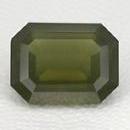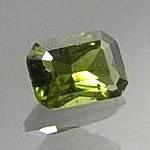|
ClassicGems.net |
|
|
 |
|
Ekanite |
|
|
Discovered in 1953; IMA status: Valid (IMA approved 1958) |
|||
|
|
|
Chemistry |
|
|
|
|
|
Ca2ThSi8O20 |
|
|
|
Calcium Thorium Silicate |
|
Molecular Weight: |
856.87 gm |
|
Composition: |
Calcium |
9.35 % |
Ca |
13.09 % |
CaO |
|
|
Thorium |
27.08 % |
Th |
30.81 % |
ThO2 |
|
|
Silicon |
26.22 % |
Si |
56.10 % |
SiO2 |
|
|
Oxygen |
37.34 % |
O |
|
|
|
|
|
100.00 % |
|
100.00 % |
= TOTAL OXIDE |
|
|
|
||||
|
Classification |
|
|
|
|
|
Silicates (Germanates) |
|
|
8/E.10-10 |
|
|
|
9 : SILICATES (Germanates)
|
|
Related to: |
None |
|
Members of Group: |
None |
|
Varieties: |
None |
|
Synonyms: |
None |
|
|
|
|
Crystal Data |
|
|
|
|
|
Tetragonal - Trapezohedral (may be metamict - a mineral originally crystalline, eventually amorphous due to radiation damage) |
|
|
Poorly-formed pyramidal crystals, to 1 cm, as clusters of grains; rounded massive. |
|
|
None |
|
|
|
|
|
Physical Properties |
|
|
|
|
|
Distinct on [101], indistinct on [001] |
|
|
Irregular, Uneven |
|
|
Brittle |
|
|
5.0 - 6.5 |
|
|
3.28 - 3.32 (g/cm3) |
|
|
None |
|
|
Strong; GRapi = 542,060.77 (Gamma Ray American Petroleum Institute Units) |
|
|
Other: |
May be metamict due to radiation. |
|
|
|
|
Optical Properties |
|
|
|
|
|
Colorless, Yellow, Light to Dark Green, Brown, Red from inclusions |
|
|
Transparent to Translucent |
|
|
Vitreous |
|
|
1.590 - 1.596 Uniaxial ( - ) |
|
|
0.0120 |
|
|
n/a |
|
|
n/a |
|
|
|
|
|
Occurances |
|
|
|
|
|
Geological Setting: |
Detrital (Sri Lanka); in a glacial erratic syenitic boulder (Tombstone Mountains, Canada); in volcanic ejecta (Case Collina, Italy). |
|
Common Associations: |
Fluorite, Garnet, Quartz, Microcline, Clinopyroxene, Apatite, Sodic Plagioclase, Hematite, Thorogummite, Zircon, Titanite (Tombstone Mountains, Canada); Quartz, Feldspar, Pyroxene (Case Collina, Italy). |
|
Common Impurities: |
U, Fe, Pb, Al, Mn, Pb, Mg |
|
Type Locality: |
Ehiliyagoda (Ehaliyagoda), Ratnapura, Sabaragamuwa Province, Sri Lanka |
|
Year Discovered: |
1953 (IMA approved 1958) |
|
View mineral photos: |
|
|
|
|
|
Unusual Gem Categories |
|
|
|
|
|
Metamict Gems, Radioactive Gems |
|
|
|
|
|
More Information |
|
|
|
|
|
|
|
|
|
|
|
Ekanite is an extemely rare gem. It was discovered in 1953 in the gem gravels at Eheliyagoda, near Ratnapura, Sri Lanka. It is also found at Mt. Sainte Hilaire, Quebec, Canada. Ekanite may be strongly radioactive as defined in 49 CFR 173.403 (greater than 70 Bq/gram) due to the presence of Thorium (Th). Ekanite is found in shades of green and brown. Ekanite is a strongly radioactive mineral and should be stored away from other gems and minerals that are subject to damage from radioactivity and of course human exposure should be limited. Ekanite is metamict due to its strong radioactivity. Metamictization is a natural, gradual process of the destruction of the internal crystal structure of a mineral due to radiation present in the mineral or from nearby external radiation. Metamictization eventually leaves the mineral amorphous, or without any internal crystal structure. Once this process is complete the mineral is desctibed as metamict. Ekanite was named after Mr. F. L. D. Ekanayake of Colombo, Sri Lanka, customs officer and Fellow of the Gemmological Association, who came across two unusual gemstones in the local Colombo gem market in 1953. Initially, the stones were suspected to be a devitrified antique glass but Mr. Ekanayake was convinced the material represented a new gem variety and mineral species. It was determined that the raw material came from a gravel pit at Ehiliyagoda (Ehaliyagoda), Ratnapura, Sabaragamuwa Province, Sri Lanka. It was eight years before an article about the new mineral was published in 1961 and finally approved by the IMA and named after Mr. Ekanayake in 1967. Ekanite is almost always completely metamict. Metamictization is a natural, gradual process of the complete destruction of the internal crystal structure of a mineral due to radiation present in the mineral or from nearby external radiation. Metamictization eventually leaves the mineral amorphous or without any internal crystal structure. Once this process is complete the mineral is desctibed as metamict. |
|
|
Ekanite gems for sale:
|
|||||||||||||||||||||||||||

